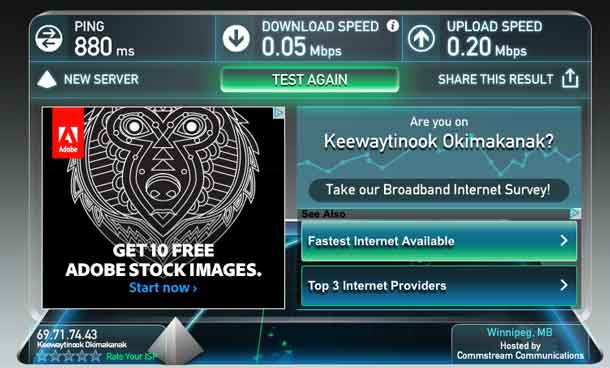
THUNDER BAY – Internet access is almost at the point of being a basic need. For education, business, and healthcare the ability to connect to high-speed Internet is increasingly critical.
Across Northwestern Ontario, the speed of Internet in different communities varies greatly. Internet speed has a direct relationship to business speed.
In Neskantaga First Nation the speed of the Internet is extremely slow. Imagine logging on to your email and the Internet is so busy it simply drops your connection. Or it takes several minutes to log on to a website. The speed of Internet in the community is a part of the issue with the water problem. There is simply not enough speed for a direct live-time monitoring of the Water Treatment Plant.

This slow Internet also impacts youth in the community. Something many people take for granted, enjoying a movie on Netflix or another online service can take up hours of time simply in waiting for the download.
For education, the Internet is slow too and that impacts teachers in offering help to students and making a real difference in the lives and learning time for their time in class.
It is not just remote First Nation communities where slow Internet is an issue.
The speed of the Internet, measured by www.speedtest.net, provides an indication of how fast your local Internet access operates.
 Speeds of the Internet have improved drastically in recent years. In Northwestern Ontario for remote communities there are several initiatives coming forward to provide Northern communities with higher speed Internet.
Speeds of the Internet have improved drastically in recent years. In Northwestern Ontario for remote communities there are several initiatives coming forward to provide Northern communities with higher speed Internet.
In Thunder Bay, TBaytel is offering extremely fast Internet via the company’s Fibre Internet.
The Nishnawbe-Aski Nation Broadband project, an effort of NAN, the province of Ontario and Bell Aliant is working toward providing high-speed broadband Internet for all NAN Communities.
“NAN continues to monitor the progress of the Northwestern Ontario Broadband Expansion Initiative between Bell Aliant and the governments of Ontario and Canada, and looks forward to internet parity for the northern First Nations. It will provide access to modern communications services for NAN membership and especially youth as they advance their careers. The initiative will allow for greater education opportunitites, provide support for telemedicine, and be a valuable tool for First Nations regarding the impending economic and resource development opportunities from their traditional territories”.






